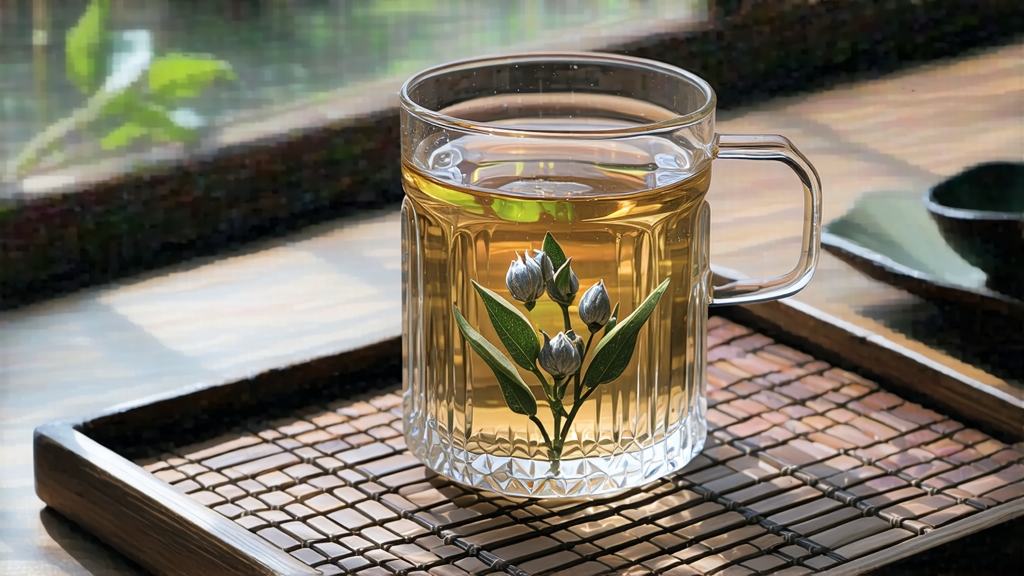
If green tea is spring’s first cry and pu-erh an autumn epic, then Fuding White Needle—Bai Hao Yin Zhen in Chinese—must be the hush that falls between stars. Harvested only in the first ten days of April, when the air on the Taimu Mountains still carries the chill of the East China Sea, this most aristocratic of white teas is plucked before the buds have dared to open. What reaches the withering loft is a constellation of tiny spears, each wrapped in a silken duvet so dense it can be seen from across the room. Those who meet it for the first time often mistake the buds for downy willow catkins; only when hot water kisses them does the leaf reveal that it is, in fact, a living archive of Chinese tea history.
The story begins late in the Song dynasty, when imperial tribute lists first record “white medicine tea” sent northward along the Grand Canal. Caravans carried compressed bricks of coarse white material whose exact identity remains debated, but by the Ming the technique had sharpened: pick, wither, dry—no rubbing, no firing, no rolling. The port of Fuding became the embarkation point for white tea bound for Southeast Asia, where Chinese migrants valued its cooling reputation in the equatorial heat. European merchants encountered it in the early nineteenth century, cataloguing the pale infusion as “Pekoe Souchong Imperial,” a name that conflated several styles yet cemented the mystique of the down-covered bud. Modern science has since confirmed what folklore long suggested: minimal processing preserves catechins and the amino acid L-theanine in a ratio that delivers both calm focus and potent antioxidant activity.
Geography is the first, silent craftsman. The Taimu range rises only 1,000 metres above sea level, yet the diurnal swing can exceed 15 °C in April. Mist rolling in from the sea acts as a natural shade cloth, slowing photosynthesis and coaxing the plant to stockpile soluble sugars. The local cultivar, Fuding Da Bai Hao, develops a bud that is measurably plumper and hairier than cousins in Yunnan or Guizhou; under a microscope the trichomes appear as hollow tubes that will later trap volatile terpenes during withering. Soil is weathered granite topped with a shallow humus layer—poor in nitrogen but rich in potassium and fluoride, a combination that tightens cell walls and lengthens the bud’s shelf life without refrigeration.
Plucking rules are almost monastic. Only the terminal bud is taken, and only on days when the dew has lifted but the sun is still mild. Experienced pickers use a twisting motion that leaves the tiny stipule attached, a detail that prevents oxidation from starting at the scar. A full kilogram of finished tea demands roughly thirty thousand buds, all carried downhill in shallow bamboo baskets lined with banana leaf to prevent compression. Time is the enemy: the journey from tree to withering loft must finish within two hours, before enzymatic browning sets in.
Withering is where craft turns into choreography. Traditionally the buds are laid two centimetres deep on bamboo trays stacked like drawers in a drafty loft whose windows face north. For the first sixteen hours the ambient temperature is kept below 22 °C; humidity hovers at 70 %. Every forty minutes a master gently lifts and turns the buds, allowing each side to meet the mountain breeze. Around midnight the trays are consolidated—thicker piles, slightly higher temperature—to coax a modest enzymatic lift that deepens aroma. By dawn the moisture content has fallen from 75 % to 20 %, and the buds have curled into the shape of tiny fishhooks, their down now the colour of polished pewter. A final thirty minutes at 40 °C in a charcoal-heated perforated drum halts residual enzymes without adding roast flavour. The result is tea that is technically dry yet still breathes; cupped in the palm, it feels cool against the skin, like marble in shade.
Storage is the forgotten step. Because white tea continues to evolve, it must rest for at least six weeks in an environment of 50 % relative humidity and temperatures below 25 °C. During this “quiet month” the grassy aldehydes recede, allowing floral lactones to surface. Connoisseurs often age Bai Hao Yin Zhen for five years